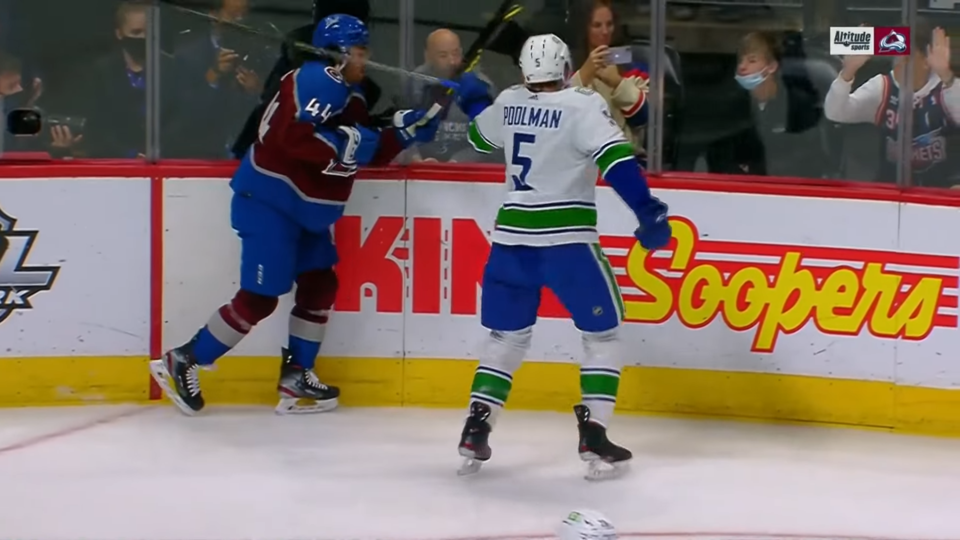The NHL’s Department of Player Safety has made it very clear over the past several years that they don’t particularly care about dangerous hits from behind or checks to the head but there’s still one type of infraction that they take very seriously: things that are deemed to be “non-hockey plays,” particularly if they're stick-based.
That’s why Tucker Poolman got a two-game suspension for hitting Kiefer Sherwood near the end of the Â鶹´«Ă˝Ół»Canucks’ game against the Colorado Avalanche.
“This is not a hockey play,” said the DoPS in their . “This is an intentional and retaliatory stick swing that strikes an opponent directly in the head and such actions cannot be excused.”
Poolman received a five-minute major and a match penalty for the infraction.
The DoPS also noted that Poolman has no history of being fined or suspended, which likely played a role in why his suspension wasn’t longer. It also helps that Sherwood did not appear to be seriously injured on the play. Slashes to the head can be extremely dangerous, as Canucks fans should be well aware.
Back in 2000 in a game between the Canucks and the Boston Bruins, , knocking him unconscious. Brashear collapsed to the ice, hitting the back of his head on the ice, and suffering a seizure. McSorley was suspended indefinitely and was even found guilty of assault with a weapon and served 18 months of probation.
Poolman’s stick swing obviously doesn’t rise to the same level, as it was a one-handed swing with less force but it still had to result in a suspension. You just can’t hit a guy in the head with your stick away from the play, particularly when it’s intentional rather than just losing control of your stick.
When George Parros took over the Department of Player Safety, he made it a point of emphasis that he wanted to crack down on such non-hockey plays.
“I've always thought that they could have been a bit harsher on certain plays that I felt where clearly someone intended to do something that was away from the play, had nothing to do with the game and no benefit other than to disable or hurt a person,” Parros said. “Just trying to go a little bit harder on those, because I felt it's been soft in some instances.”
Parros felt that other plays were less of a concern, which has been reflected by some of the baffling decisions the DoPS has made in the subsequent years.
“We used to be worried about headhunting and major things like that,” Parros said. “Now we're worried about slashing and some more minor infractions, you might say. So the game's in a good place. There doesn't need to be a huge shake-up, a huge change in philosophy.”
The consequences for the Canucks are significant. In their two remaining games on their road trip, they will be missing three defencemen from their right side: the suspended Poolman, the injured Luke Schenn, and Travis Hamonic, who did not travel to the U.S. likely because of his presumed status as an “Unvaccinated Individual” according to the NHL’s COVID-19 protocol.
As a result, they’ll face the Vegas Golden Knights and Anaheim Ducks with a severely depleted defence corps.
The Canucks have called up Madison Bowey from the AHL in case they need him for one or more of the next two games. With the addition of Bowey, here’s what the Canucks’ defence corps looks like:
Quinn Hughes - ???
Oliver Ekman-Larsson - Tyler Myers
Jack Rathbone - Kyle Burroughs
Brad Hunt - Madison Bowey
One of those defencemen is going to need to play on the right side with Hughes. The Canucks could bump Myers up to play with Hughes but then will have to use one of the remaining defencemen with Ekman-Larsson in a shutdown role.
Both Hunt and Bowey have NHL experience but Hunt has primarily been used in a bottom-pair role and would be playing on his off-side on the right, while Bowey has faced some significant defensive issues at the NHL level.
Bowey has played significant minutes before with the Detroit Red Wings, so maybe he’s the better option but Hunt has generally had better results in the NHL. It’s a bit of a lesser-of-two-evils situation — neither is ideally suited for the role.
The Canucks' defence has managed to limit shots against for the most part this season but have still given up a high number of dangerous scoring chances and struggled to transition the puck up ice. Will they be able to survive while missing so many of their right-handed defencemen?




